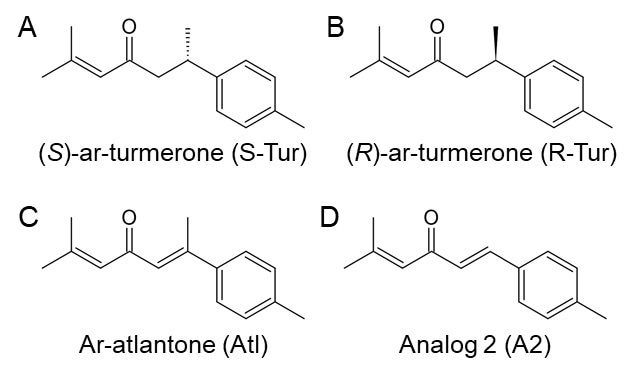Scientists from Japan’s Kumamoto University discovered that aromatic turmerone (ar-turmerone), a compound extracted from turmeric essential oil, and its derivatives have a direct effect on the dopaminergic nerves to produce a neuroprotective effect on tissue cultures of a Parkinson’s disease model.

Ar-turmerone has an asymmetric carbon that naturally exists in a structure similar to A (S-Tur). Researchers identified three analogs (B, C, and D) that have stronger anti-inflammatory activity than S-Tur. Image Credit: Adapted from Fig. 1 (A, B, C, and G) of Hori, Y. et.al., Cells, 2021.
This occurs due to the increased cellular antioxidant potency resulting from the activation of Nrf2. The research team considers that derivatives of ar-turmerone discovered through their research can be employed as new therapeutics for Parkinson’s disease.
The neurodegenerative disorder Parkinson’s disease occurs as a result of selective death of dopaminergic neurons that transmit information from the substantia nigra of the midbrain to the striatum, resulting in lower levels of dopamine production.
Parkinson’s is characterized by immobility, limb tremors, muscle rigidity, and other movement disorders. Right now, it is treated with dopamine supplements; however, there is no means to inhibit dopaminergic neurodegeneration.
Earlier research works found that the inflammatory response produced by the activation of microglia (cells in charge of immune function in the brain) is noticed in the substantia nigra of the midbrain of patients with Parkinson’s disease.
Additional experiments to mirror the in vivo state of the midbrain (midbrain slice culture) showed that microglial activation activates the selective degeneration of dopaminergic neurons in the substantia nigra, and that nitric oxide (NO) produced from activated microglia was part of the neurodegeneration.
The study outcomes indicate that compounds that have anti-inflammatory effects on microglia may inhibit dopaminergic degeneration.
The team examined aromatic turmerone (ar-turmerone), the main constituent of turmeric essential oil found to exhibit anti-tumor and anti-inflammatory effects on microglia.
The researchers employed the midbrain slice cultures and BV2 microglial cell line to identify whether ar-turmerone inhibits dopaminergic neurodegeneration by its anti-inflammatory effects, and to determine structurally similar compounds (derivatives) that may have greater anti-inflammatory and neuroprotective effects.
Ar- turmerone possesses an asymmetric carbon (S-Tur), hence the scientists created eight analogs and tried to determine the ones with powerful anti-inflammatory effects.
The researchers employed the inhibitory effects on the inflammatory response as produced by lipopolysaccharide (LPS)-stimulated activation of BV2 cells as an indicator. The analogs (R)-ar-turmerone (R-Tur), ar-atlantone (Atl), and analog 2 (A2) exhibited higher anti-inflammatory effects when compared to S-Tur.
To investigate the inhibitory effect of S-Tur and other compounds on dopaminergic degeneration, the scientists examined midbrain slice cultures where the microglial activation was triggered by interferon-γ and LPS stimulation (IFN- γ/LPS). The four compounds substantially inhibited a decrease in the number of dopaminergic neurons as induced by IFN- γ/LPS.
The formation of NO, released from activated microglia and involved in dopaminergic neurodegeneration, was not inhibited. Additionally, three compounds (S-Tur, Atl, and A2) suppressed dopaminergic degeneration induced by MPP+, a toxin selectively damaging dopaminergic neurons independent of microglial activity.
The findings indicated that S-Tur and its derivatives (Atl and A2) directly impact dopaminergic neurons and show neuroprotective effects. Moreover, analysis with midbrain slice cultures and dopaminergic progenitor cell lines showed that the neuroprotective effects of Atl and A2 are induced by activation of Nrf2, a transcription factor that increases the antioxidant potency of cells.
Our study elucidated a new mechanism by which ar-turmerone and its derivatives directly protect mesencephalic slice dopaminergic neurons, independent of their previously reported anti-inflammatory effects on microglia.”
Takahiro Seki, Associate Professor, Kumamoto University
Professor Seki headed the research.
We showed that two derivatives, Atl and A2, exhibit neuroprotective effects by increasing the expression of antioxidant proteins through the activation of Nrf2. In particular, the analog A2 identified in this study is a potent activator of Nrf2 and is assumed to have a strong antioxidant effect.”
Takahiro Seki, Associate Professor, Kumamoto University
“We think it is possible that this compound may be a new dopaminergic neuroprotective agent for Parkinson’s disease treatment, and it could also be used to treat other diseases caused by oxidative stress, such as liver and kidney diseases,” added Professor Seki.
Source:
Journal reference:
Hori, Y., et al. (2021) Aromatic-Turmerone Analogs Protect Dopaminergic Neurons in Midbrain Slice Cultures through Their Neuroprotective Activities. Cells. doi.org/10.3390/cells10051090